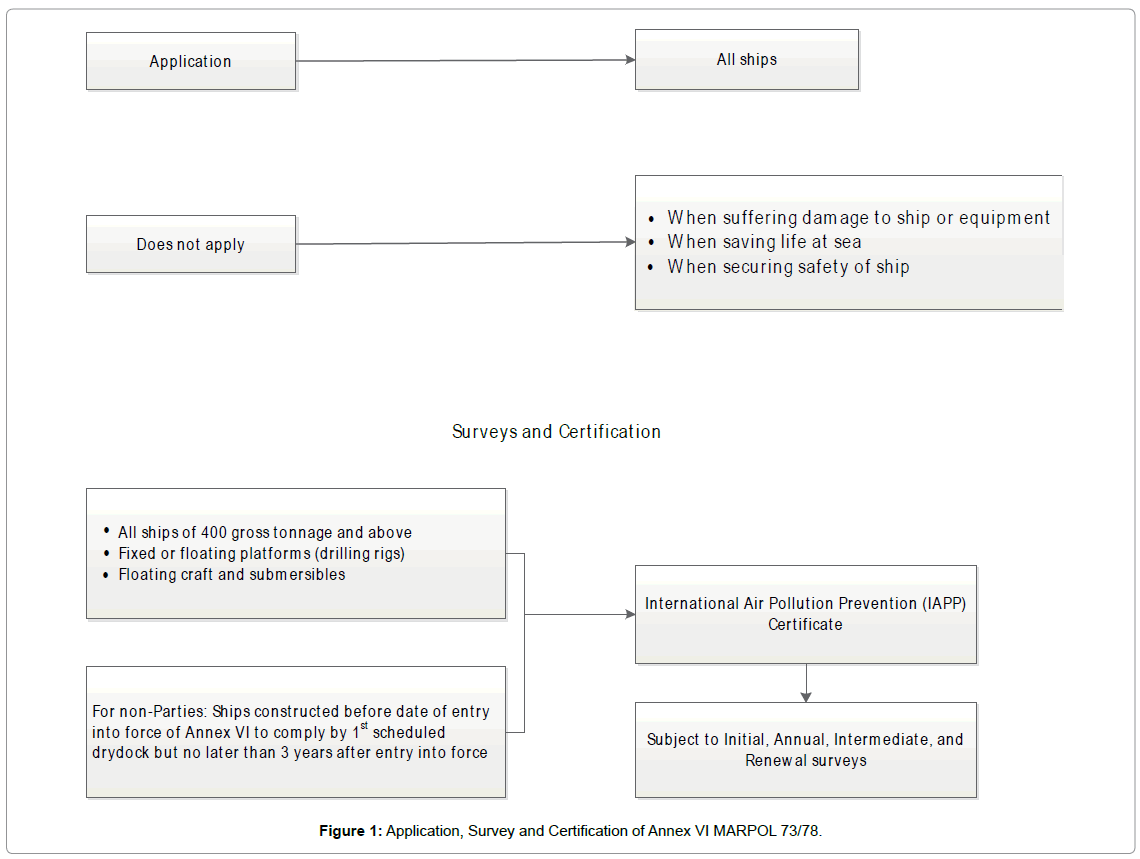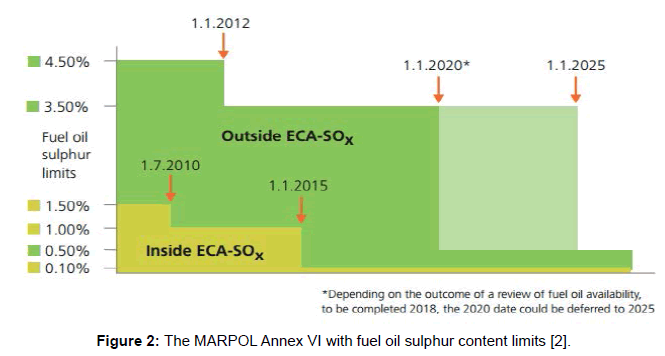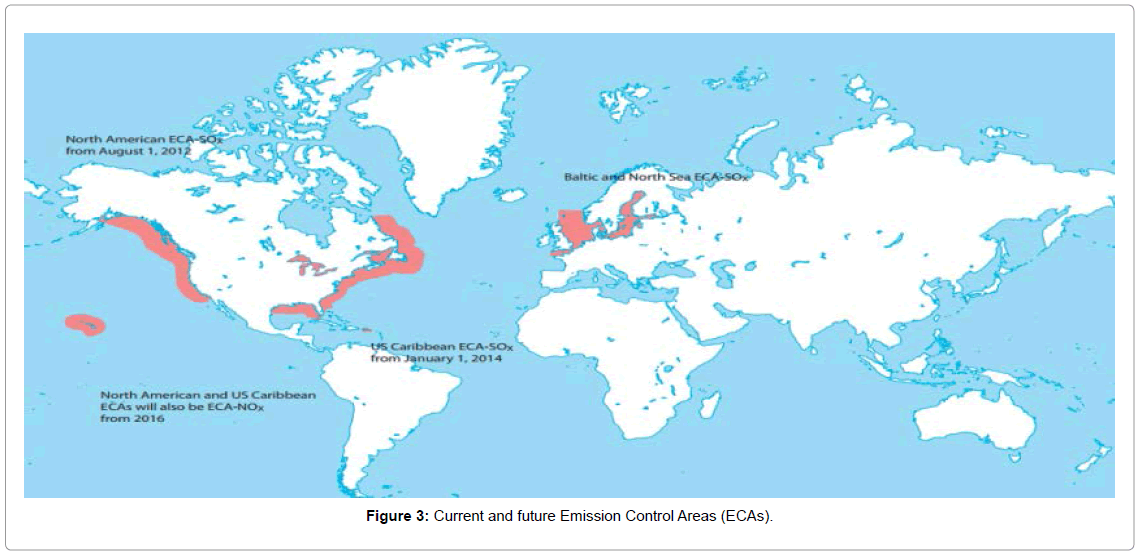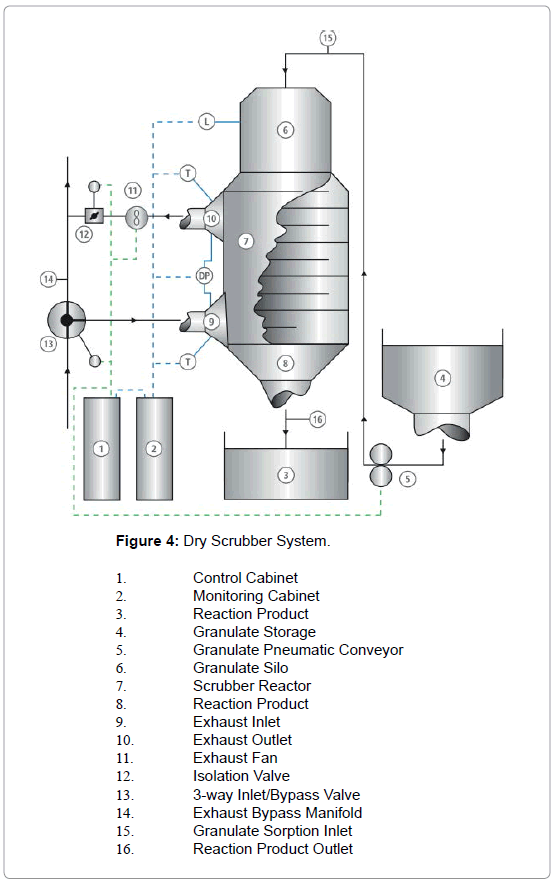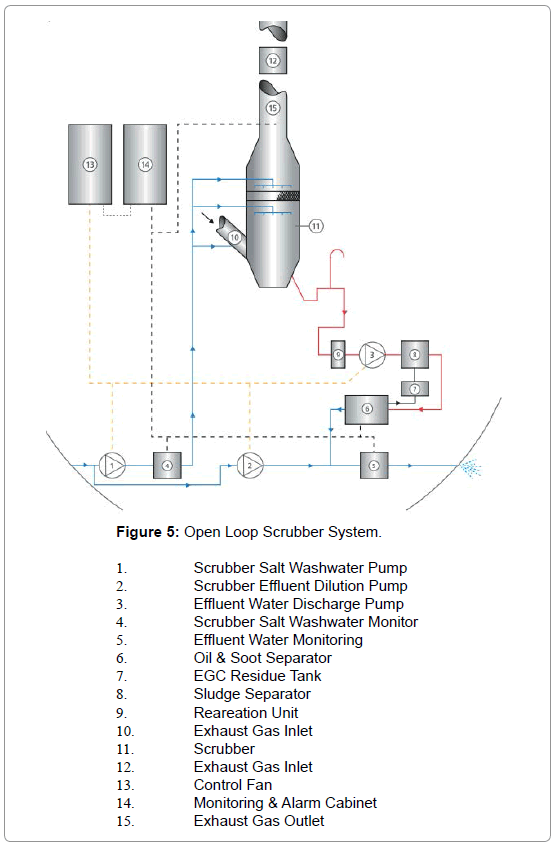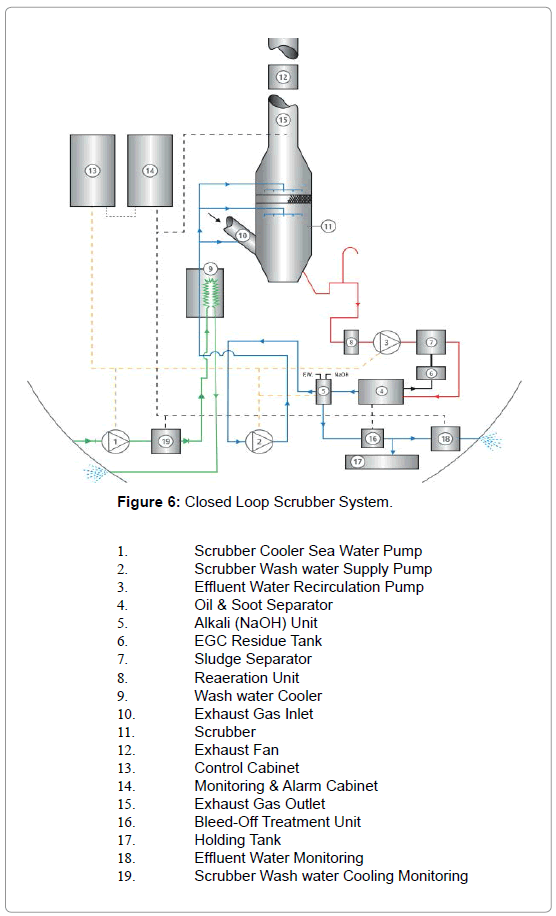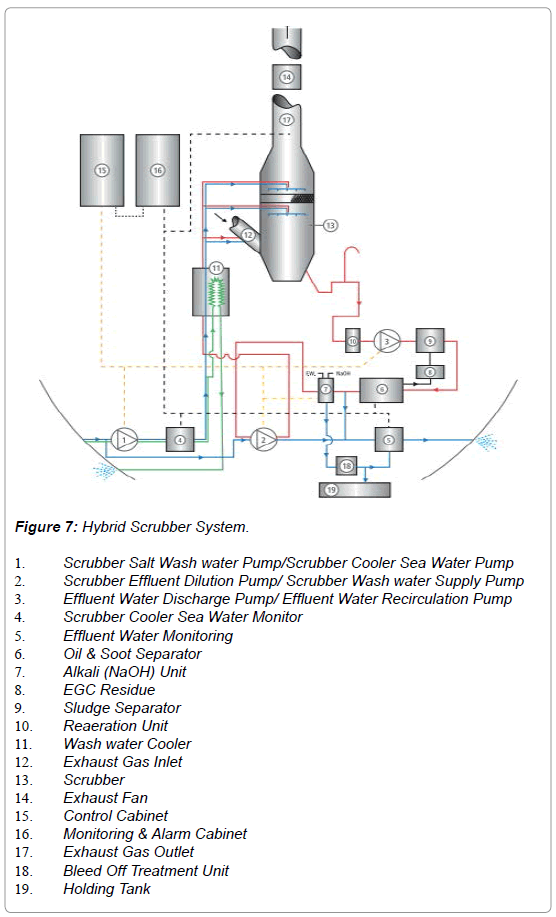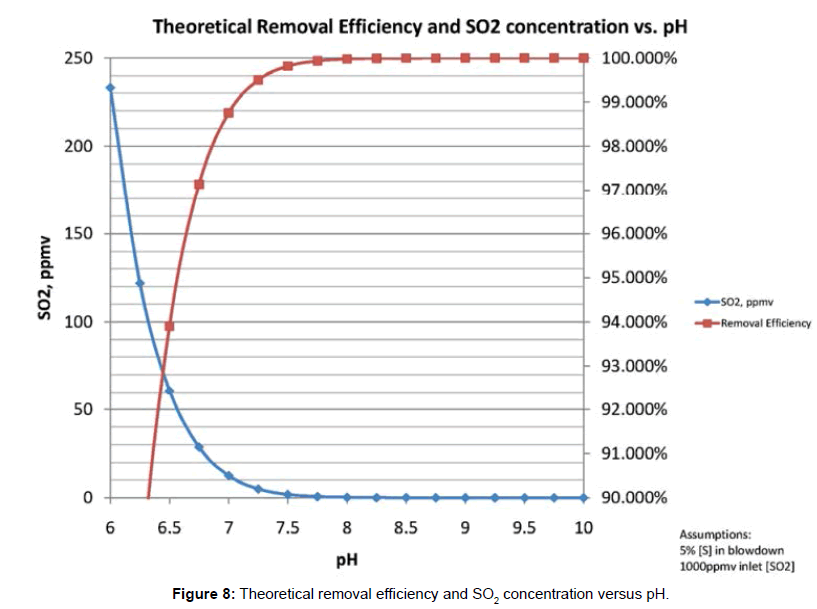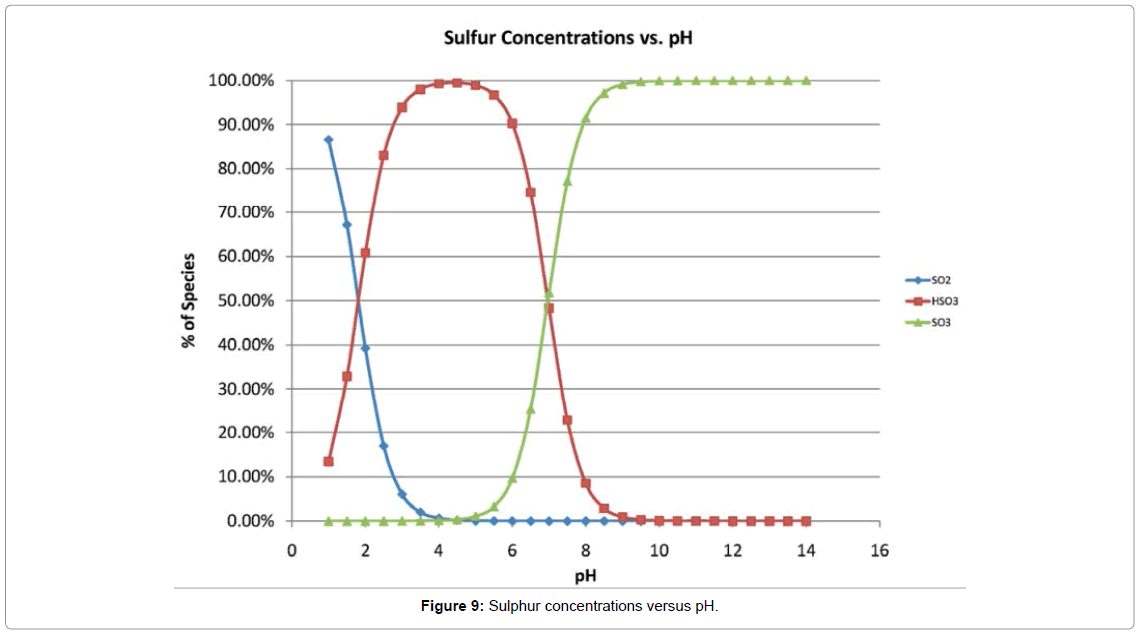Research of the Scrubber Systems to Clean Marine Diesel Engine Exhaust Gases on Ships
Received: 04-Oct-2017 / Accepted Date: 30-Oct-2017 / Published Date: 01-Dec-2017 DOI: 10.4172/2155-9910.1000243
Abstract
In the shipping transportation industries, they brigh a lot of economical values with rising a number of fleets. Unfortunately, this development always encloses to the environmental pollution issue. “International Maritime Organization (IMO)” has been adopted all member states of nations that are being operated and managed the ocean by means of giving out the “International Convention for the Prevention of Pollution from Ships (MARPOL 73/78)”. In where, the exhaust gas cleaning system has been known as an optimal solution to reduce SOx emissions from diesel engine exhaust gas on board. In this article, the structures of sulphur scrubber exhaust gas cleaning systems have been researched along with their cleaning methodology. Based on the working performance of their systems on ship, there is a comparison of efficiency that it will help ship-owners selected effectively in ship operation. The results of this article have identified that the reduction of SOx gas emission reaches to 95% and PM (Particulate Matter) reduction efficiency aims 60%. So, the use of Scrubbers to reduce sulphur content in marine diesel engines approaches reliably in ship operation nowadays
Keywords: Main diesel engine; Exhaust gas emission; Low sulphur fuel oil; Exhaust gas cleaning system
Introduction
The shipping transportation industry plays an important role in the economic development of each nation that has a sea bounder. Furthermore, it becomes a key component to the development of world with over 90% of global trade that is carried by sea. The sea-going vessels contribute more than 100 gigatonnes (GT) with over 104,000 total ships nowadays [1]. Annual, the shipping transportation industry has given a big reputation from maritime activities. However, the ship operation activities also emit a large amount of exhaust gases to the environment. So, the environmental pollution issue is a big field nowadays [2,3]. In this article, the shipping transportation industry has been referred along with harmful gas emissions from this industry. In addition, this emission includes some gases like as carbon dioxide (CO2), carbon monoxide (CO), oxides of sulphur (SOx), nitrogen oxides (NOx), hydrocarbons, water vapor [4]. NOx and SOx are of special concern as threats to vegetation, the environment and human health. Due to, the environment protection plays a virtal role in economic development. This emphasizes NOx control, SOx limitation, particulate matter control and to an increasing extent, CO2 emission, the latter reflecting total engine efficiency. On the other hand, the harmful gas emissions concerns about energy efficiency measures of IMO. Energy Efficiency Operational Indicator (EEOI), Ship Energy Efficiency Management Plan (SEEMP) for exiting ships and Energy Efficiency Design Index (EEDI) for new ships are energy efficiency measure indexes due to IMO proposed. One another side, there were some related researches about energy efficiency management of ships likes as calculating and assessing EEDI index for bulk carrier have been proposed by Tran [5]. A tool of EEOI calculation has been conducted for bulk carriers in VINIC shipping transportation company, Vietnam [6]. Moreover, the implementation of energy efficiency management needs to extend for shipping sectors. The measures of high implementation have been concentrated for over thirty energy efficiency and CO2 emission reduction technologies [7]. Winnes and Fridell had studied two fuel oil qualities-heavy fuel oil (HFO) and marine gas oil (MGO) for four stroke main engines [8]. The subsequent effects on ship exhaust gas emissions will impact on sea environment with a focus on particulate matter (PM). In addition, the emission characteristics of SO2 and particulate matter (PM) of high sulphur fuel oil and low sulphur fuel oil have been represented by Zhou [9]. Besides that, following the current regulations, Langella et al., has analyzed to switch from HFO (Heavy Fuel Oil) to MGO (Marine Gas Oil) and provided graphically and represented meaningful insights for marine traffic on sea environment quality [10].
On the other hand, the particle level in exhaust gas concerns about the sulphur content in fuel oil. “International Maritime Organisation (IMO)” and the European United (EU) have introduced a restriction of sulphur of no more than 0.10% from 1 January 2015, against the limit of 1.00% in effect up until 31 December 2014 in SECA areas (Sulphur Emission Control Area) like the North Sea and Baltic Sea in Northern Europe. The emission area rules, e.g., in Sweden and Norway are trying to decrease particulate emissions substantially. The equipment has been used on board including main diesel engine, auxiliary machinery. In addition, some other ones are provided for safety and security on ship. So, it is necessary to provide the control technology research of exhaust gas emission from operating ships. In this research, the exhaust gas cleaning system with name the exhaust gas scrubber systems that was researched with its structure, working principle, and the cleaned effects of this system in order to reduce the sulphur content in exhaust gas from ships nowadays. In this article, the research content is divided into five sections; introduction, contents of Annex VI MARPOL 73/78, operational principle of exhaust gas cleaning system, results and conclusion.
Contents of the Annex VI, MARPOL 73/78
“International Maritime Organization (IMO)” is a ‘United Nations’ specialized agency that was established with a mission to protect safety and prevention pollution from ships through “Marpol Annex VI – Regulations for the Prevention of Air Pollution from Ships”. In October 2008, the “International Maritime Organization (IMO)” has adopted to set amendments about Annex VI of the MARPOL Convention. The amendments especially concern about sulphur content level limit in marine fuel oil. Besides that, they also provided with a reduction of the sulphur content in marine fuel oil following: from 1 January 2012, the global sulphur cap will be reduced. Firstly, the reduction of sulphur content limit in marine fuel oil is to 3.50% comparing with current level is 4.50% and then, the subject is a feasibility review to be implemented no later than 2018. On the other hand, the progress is to 0.50% from 1 January 2020. In the Sulphur Emission Control Areas (SECAs), the requirements are more stringent. Especially, from 1 July 2010, the maximum sulphur limit has been reduced to 1.00% from 1.50% while from 1 January 2015, the limit will be further reduced to 0.10%.
In general, Marpol Annex VI with application, survey and certification in Figure 1.
Moreover, following the Regulation 14, Sulphur oxides (SOx) and particulate matter emission controls apply to all fuel oil, and especially from 1 January 2015, all ocean-going vessels travelling within the Emission Control Areas including the English Channel, Baltic Sea, North Sea, North American and US Caribbean Sea areas must use fuel oil with less than 0.10% sulphur. To understand the IMO’s regulations, Marpol Annex VI regulates the emissions from ships engaged in the international trade and regulations 4, 13 and 14 are particularly relevant (Figure 2).
Figure 2: The MARPOL Annex VI with fuel oil sulphur content limits [2].
Regulation 14: In this regulation, it is placed the limits on the sulphur content of the fuel oil in aims with restricting the SOx and particulate matter (PM) emissions, and is applicable to all ships in service. There is a difference between inside and outside are of emission control areas and the speed reduction of engine follows the time, it is showed in Figure 1 above.
On the other hand, two ECA-SOx with Baltic and the North Sea which includes the English Channel are currently in effect and well established from 1 August 2012, a third with the North American ECASOx will enter into effect while a fourth – the US Caribbean ECA-SOx is intended to enter into effect in January 2014. Figure 3 will be showed the geographical extent of these areas (Table 1).
| Outside an ECA established to limit SOx and particulate matter emissions | Inside an ECA established to limit SOx and particulate matter emissions |
|---|---|
| 4.50% m/m prior to 1 January 2012 | 1.50 % m/m prior to 1 July 2010 |
| 3.50% m/m on and after 1 January 2012 | 1.00% m/m on and after 1 July 2010 |
| 0.50% m/m on and after 1 January 2020* | 0.10% m/m and after 1 January 2015 |
Table 1: Outside and Inside an ECA to limit SOx and Particulate Matter (PM) emissions.
These fuel oil sulphur limits (expressed in terms of % m/m – that is by mass) are subject to a series of step changes over the years, regulations 14.1 and 14.4:
The ECAs established are:
1. “Baltic Sea area – as defined in Annex I of MARPOL (SOx only)”;
2. “North Sea area – as defined in Annex V of MARPOL (SOx only)”;
3. “North American area (entered into effect 1 August 2012) – as defined in Appendix VII of Annex VI of MARPOL (SOx, NOx and PM)”;
4. “United States Caribbean Sea area (entered into effect 1 January 2014) – as defined in Appendix VII of Annex VI of MARPOL (SOx, NOx and PM)”.
Operational Principle of Exhaust Gas Cleaning System
The exhaust gas cleaning system is known as another name: A Scrubber. It is a device that is installed in the exhaust gas system of the engine and boiler. It is used to treat the exhaust gas with a variety of substances including sea water, chemically treated fresh water or dry substances so as to remove most of the SOx from the exhaust and reduce PM (Particulate Matter) to some extent. After scrubbing, the cleaned exhaust is emitted into the atmosphere. All scrubber technologies create a waste stream containing the substance used for the cleaning process plus the SOx and PM removed from the exhaust gas of the engines and boilers.
SOx (SO2 plus SO3) gases are water soluble. Once dissolved, these gases from strong acids that react with the natural alkalinity of the seawater, or the alkalinity derived from the added substances (normally sodium hydroxide), forming soluble sodium sulfate salt, which is a natural salt in the seas. In addition, the PM in the exhaust will become entrapped in the wash water, adding to the sludge generated by a scrubber. With dry scrubbers calcium hydroxide (Ca(OH)2), or hydrated lime as it is more commonly known, reacts with the SOx and solid calcium sulfate (CaSO4), or gypsum as it is more commonly known, is the product of the reaction. The waste stream and generated sludge have to be processed as per the IMO guidelines before discharge overboard, where allowed or stored and discharged to shore as a waste substance.
Dry scrubbers
A dry scrubber does not use water or any liquid substances to carry out the scrubbing process but exposes hydrated lime-treated granulates to the exhaust gas to create a chemical reaction that removes the SOx emission compounds. Since the exhaust gas does not pass through water so it is not cooled and therefore dry scrubbers can be placed before an exhaust gas economizer (EGE) or used in conjunction with SCR units which typically require exhaust gas temperatures above 350°C to enable the catalysts to operate correctly, to reduce both SOx and NOx emissions.
Dry scrubbers use granulates with caustic lime (Ca(OH)2) which reacts with sulphur dioxide (SO2) to form calcium sulfite:
 (1)
(1)
Calcium sulfite is then air-oxidized to form calcium sulfate dehydrate or gypsum:
 (2)
(2)
Reaction with sulphur trioxide (SO3) is:
 (3)
(3)
Which with water forms: CaSO4.2H2O (Gypsum)
Hence there is no CO2 release. The Couple System dry scrubber works by feeding dry pellets of hydrated lime treated granulated through a packed bed absorber. The hydrated lime reacts with the hot exhaust gas and absorbs the SOx components to form pellets of gypsum, a non-toxic harmless substance, commonly used in the construction of houses. The gypsum-containing pellets are removed from the absorber and stored on board for disposal ashore. Transport of the pellets to and from the absorber is achieved pneumatically. An exhaust gas bypass is required for periods during which the scrubber is not in operation or when its operation is not required. Testing has been carried out so far on one vessel with a medium-speed main propulsion engine. Couple Systems claims a SOx removal effectiveness of up to 99 percent and PM reduction of approximately 60 percent.
Wet scrubbers
Wet Scrubbers pass the exhaust gas through a liquid media in order to remove the SOx compounds from the gas by chemically reacting with parts of the wash liquid. The most common liquids are untreated sea water or chemically treated fresh water. Sea water scrubbers are normally open loop-type, where the water is sourced and discharged from outside the system and the water flows only once through the unit. In a closed loop scrubber, the treatment water is cleaned and recycled back to the scrubber in a continuous closed loop. In a closed loop system particulate matter and the water treated to maintain its pH and then make it suitable for reuse in the scrubber.
Wet SOx scrubbers system is a simple, effective technology that has been used in industrial applications for many years. Wet SOx scrubbers broadly comprise the following components (Figure 4).
Figure 4: Dry Scrubber System.
1. Control Cabinet
2. Monitoring Cabinet
3. Reaction Product
4. Granulate Storage
5. Granulate Pneumatic Conveyor
6. Granulate Silo
7. Scrubber Reactor
8. Reaction Product
9. Exhaust Inlet
10. Exhaust Outlet
11. Exhaust Fan
12. Isolation Valve
13. 3-way Inlet/Bypass Valve
14. Exhaust Bypass Manifold
15. Granulate Sorption Inlet
16. Reaction Product Outlet
• A scrubber unit – a vessel or series of closely coupled components which bring water into intimate contact with the exhaust gas from one or more combustion units. The unit is typically mounted high up in the ship in or around the funnel.
• A treatment plant for conditioning of washwater before discharge overboard;
• A residue handling facility for sludge separated from the wash waster;
• A scrubber control and emissions monitoring system.
These components will be interconnected by pipework with various pumps, coolers and tanks, depending on the scrubber system configuration. One piping system and wash water treatment plant may service more than one scrubber. These will also be a monitoring and control system, with instrumentation either dedicated to a single scrubber or shared across an integrated system.
Open loop scrubbers: An open loop-type scrubber uses sea water as the medium for cleaning or scrubbing the exhaust as shown in Figure 5.
Figure 5: Open Loop Scrubber System.
1. Scrubber Salt Washwater Pump
2. Scrubber Effluent Dilution Pump
3. Effluent Water Discharge Pump
4. Scrubber Salt Washwater Monitor
5. Effluent Water Monitoring
6. Oil & Soot Separator
7. EGC Residue Tank
8. Sludge Separator
9. Reareation Unit
10. Exhaust Gas Inlet
11. Scrubber
12. Exhaust Gas Inlet
13. Control Fan
14. Monitoring & Alarm Cabinet
15. Exhaust Gas Outlet
Sea water is normally supplied by a dedicated pump. CO2 dissolves in sea water forming carbonic acid, bicarbonate or carbonate ions depending on the pH. The positive companion ion can be calcium (Ca2+) or sodium (Na+), here the sodium carbonate salt is used as an example. When the carbonate/bicarbonate ion reacts with an acid CO2 is released.
 (Sodium Sulfite) (4)
(Sodium Sulfite) (4)
 (Sodium Sulfate) (5)
(Sodium Sulfate) (5)
 (Sodium Sulfate) (6)
(Sodium Sulfate) (6)
Each EGC system manufacture has their own techniques for how the scrubber mixes the exhaust gas and the water. As previously mentioned an open loop scrubber is only effective if the source water is alkaline. However, some river water is “hard” water with significant alkalinity, in some cases higher than sea water so open loop scrubbers can also work effectively to know the alkalinity of the water before this can be determined. Therefore, the effectiveness of an open loop scrubber very much depends on the chemistry of the water the vessel is operating in. This should be considered at the design and selection stage or when deploying a vessel to new areas.
After the basic scrubbing process takes place in the main scrubber tower, the exhaust mixture normally passes through a demister or water droplet separator to remove the water particles from the gas, which reduces the potential for steam generation as the exhaust exists into the atmosphere. While a steam plume is harmless, it creates the appearance of exhaust smoke being emitted, and should be avoided. Many systems incorporate, or have the option to fit, a re-heater after the EGC system unit.
The water mixture generated during the scrubbing process falls to a wet sump at the bottom of the scrubber. This water called wash water that is removed from the scrubber sump by gravity or by a pump, after passing through a deaerator in some systems, to a hydro cyclone or separator to remove the residuals are discharged to a dedicated residue tank on board. The collected residue will contain PM, ash, heavy metals, etc. removed from the fuel together with insoluble calcium sulfate, and silt entrained in the wash water drawn from the estuaries, rivers, or harbor waters. Where the source of the wash water has a large amount of siltm this silt can make up the dominant portion of the sludge volume. Sludge generated from substances in the incoming water, such as silt, is an issue only open loop – type scrubbers.
Closed loop scrubbers: In a closed loop-type scrubber, treated water is circulated through the scrubber to keep the scrubbing process independent of the chemistry of the waters the vessel is sailing in, plus there is little or no water discharged overboard from the scrubbing process, reducing the need for processing the wash water to make it suitable for discharge. Sodium hydroxide as a chemical additive is typically used in marine EGC systems to control the water alkalinity which can also be produced by electrolysis of sea water.
The closed loop scrubber internals are similar to those of an open loop scrubber, and the chemical processes to remove the SOx emissions are similar. The major difference between the two systems is that rather than going overboard, most of the circulating wash water is processed after it leaves the scrubber to make it suitable for recirculation as the scrubber wash water medium. The wash water can be fresh or salt water depending on the scrubber design. In this treatment process, the residues are removed from the water, and the water is closed again with caustic soda to restore its alkalinity.
Manufacturers claim a closed loop scrubber requires about half or less of the wash water flow than an open loop scrubber to achieve the same scrubbing efficiency. The reason for this is that higher levels of alkalinity level are ensured by the direct control of the alkalinity level using the caustic soda injection process (Figure 6).
Figure 6: Closed Loop Scrubber System.
1. Scrubber Cooler Sea Water Pump
2. Scrubber Wash water Supply Pump
3. Effluent Water Recirculation Pump
4. Oil & Soot Separator
5. Alkali (NaOH) Unit
6. EGC Residue Tank
7. Sludge Separator
8. Reaeration Unit
9. Wash water Cooler
10. Exhaust Gas Inlet
11. Scrubber
12. Exhaust Fan
13. Control Cabinet
14. Monitoring & Alarm Cabinet
15. Exhaust Gas Outlet
16. Bleed-Off Treatment Unit
17. Holding Tank
18. Effluent Water Monitoring
19. Scrubber Wash water Cooling Monitoring
In fresh water scrubbers, SO2 combines with a salt and consequently does not react with the natural bicarbonate of sea water. There is no release of CO2.
 (Sodium Sulfite) (7)
(Sodium Sulfite) (7)
 (Sodium Hydrogen Sulfite) (8)
(Sodium Hydrogen Sulfite) (8)
 (Sodium Hydrogen Sulfate) (9)
(Sodium Hydrogen Sulfate) (9)
 (Sodium Sulfate) (10)
(Sodium Sulfate) (10)
In a closed loop-type system, the dirty wash water exiting the scrubber goes to a process or circulating tank. A limited quantity of wash water from the bottom of the process tank, where the residuals have collected, is extracted using a low suction, and it goes to a hydro cyclone or separator, similar to an open loop system, where the residuals are removed or for some system the extracted water can go to a bleedoff treatment unit.
Hybrid scrubbers: There are advantages to open loop type systems, such as the avoidance of purchasing and handling caustic soda, and the avoidance of the need to process wash water. The closed loop system has the advantages that the scrubber works with the same efficiency independently of where the vessel is operating and there is little or no water discharge, making it best suited for coastal, port and inland waters. In order to utilize the advantages of both systems, some manufacturers have proposed hybrid scrubbing systems.
These operate as a closed loop system when in the open ocean, and as a closed loop system when in ECA. In Figure 7, the changeover from open to closed loop type is done by changing over the circulating pump suction from sea water to the fresh water discharge from the overboard discharge to the circulating tank.
Figure 7: Hybrid Scrubber System.
1. Scrubber Salt Wash water Pump/Scrubber Cooler Sea Water Pump
2. Scrubber Effluent Dilution Pump/ Scrubber Wash water Supply Pump
3. Effluent Water Discharge Pump/ Effluent Water Recirculation Pump
4. Scrubber Cooler Sea Water Monitor
5. Effluent Water Monitoring
6. Oil & Soot Separator
7. Alkali (NaOH) Unit
8. EGC Residue
9. Sludge Separator
10. Reaeration Unit
11. Wash water Cooler
12. Exhaust Gas Inlet
13. Scrubber
14. Exhaust Fan
15. Control Cabinet
16. Monitoring & Alarm Cabinet
17. Exhaust Gas Outlet
18. Bleed Off Treatment Unit
19. Holding Tank
Results
From the theoretical research of the exhaust gas cleaning system (or Scrubber System) is responding to the IMO’s regulations in Annex VI, Marpol 73/78 with sulphur content fuel oil is less than 0.10% from 2015 when sailing on the Emission Control Areas (ECAs). Moreover, the achievement results are analyzed and indicated that the sulphur content in the exhaust gas also reduces when using scrubbers system not only dry scrubber system but also wet scrubber system (Figure 8).
Through the result gains from collecting the data that conducted on a certain ship (bulk carrier) when installing the scrubber system on ship. It is leading to that the sulphur dioxide in the exhaust gas emission also reduces. The performance curve is dependent on these variables. Its trends also reduced with sulphur content in the blow down, the curve shifts to the right (higher pH is required). Likewise for lower inlet SO2 concentration, in case of the curve will move to the left (lower pH required).
In Figure 9, also presents the relatives between the contents of SO2, SO3 and HSO3. These curves are indicated that there are variables contents among SO2, SO3 and HSO3 after the analyzing the gained result from using scrubber systems.
Conclusion
The use of scrubbers has a great potential in the substantial social and environmental benefits as they can reduce the SOx emissions by at least 95% and PM (Particulate Matter) by at least 60%. Scrubbers can also reduce the NOx emissions, although there is no consensus as to by how much. Although the significant drop in non GHG related emissions, the widespread use of ship scrubbers can benefit populations (e.g., by avoiding some diseases) and the environment (e.g., by avoiding acid rain). On the other hand, scrubbers can also help reduce Greenhouse Gases (GHG) emissions to some extent. However, there is some concern regarding the sulphates being discharged into the sea as they can change the acidity of water. The changes could have an impact on sea water biodiversity, especially among fish species. Research on this particular aspect has been limited so far. Furthermore, element of concern is the scrubber’s end of life management and the production of the scrubber system itself which might be energy intensive.
Acknowledgement
The author wants to give a special thanks to the Key Laboratory of Marine Power Engineering & Technology (Ministry of Transportation), School of Energy and Power Engineering, Wuhan University of Technology, 1178 Heping Avenue, Wuhan 430063, P.R. China to help me completing this research.
References
- International Maritime Organisation (2012) International Shipping Facts and Figures – Information Resources on Trade, Safety, Security, Environment.
- Jean-Florent H, Pedro Andre CB (2013) Emission Reduction in the Shipping Industry: Regulations, Exposure and Solutions.
- Andrew Griffin (1994) MARPOL 73/78 and Vessel Pollution: A Glass Half Full or Half Empty? Indiana Journal of Global Studies 1: 489-513.
- Sergey Ushakov, Harald Valland, Jørgen B Nielsen, Erik Hennie (2014) Effects of high sulphur content in marine fuels on particulate matter emission characteristics. Journal of Marine Engineering & Technology.
- Tran. TA (2016) Calculation and Assessing the EEDI Index in the Field of Ship Energy Efficiency for M/V Jules Garnier, Journal of Marine Science: Research & Development 6: 212.
- Tran TA (2017) A Research on the Energy Efficiency Operational Indicator EEOI Calculation Tool on M/V NSU JUSTICE of VINIC Transportation Company, Vietnam. Journal of Ocean Engineering and Science 2: 55-60.
- Rehmatulla N, Calleya J, Smith T (2017) The Implementation of Technical Energy Efficiency and CO2 Emission Reduction Measures in Shipping. Ocean Engineering 139:184-197.
- Winnes H, Fridell E (2009) Particle Emissions from Ships: Dependence on Fuel Type, Journal of the Air & Waste Management Association 59: 1391-1398.
- Zhou J, Zhou S, Zhu Y (2017) Characterization of Particle and Gaseous Emissions from Marine Diesel Engines with Different Fuels and Impact of After-Treatment Technology, Energies 10: 1110.
- Langella. G, Iodice P, Amoresano A, Senatore A (2016) Ship Engines and Air Pollutants: Emission During Fuel Change-Over and Dispersion Over Coastal Areas. International Journal of Energy and Environmental Engineering 7: 307-320.
Citation: Tran TA (2017) Research of the Scrubber Systems to Clean Marine Diesel Engine Exhaust Gases on Ships. J Marine Sci Res Dev 7: 243. DOI: 10.4172/2155-9910.1000243
Copyright: © 2017 Tran TA. This is an open-access article distributed under the terms of the Creative Commons Attribution License, which permits unrestricted use, distribution, and reproduction in any medium, provided the original author and source are credited.
Select your language of interest to view the total content in your interested language
Share This Article
Recommended Journals
Open Access Journals
Article Tools
Article Usage
- Total views: 18032
- [From(publication date): 0-2017 - Dec 09, 2025]
- Breakdown by view type
- HTML page views: 16671
- PDF downloads: 1361

